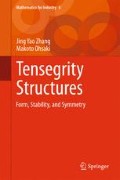Abstract
Tensegrity structures are classified as prestressed pin-jointed structures, and they have distinct properties compared to other pin-jointed structures: (1) they are free-standing, without any support; and (2) they have both tensile and compressive members. Prior to further studies on tensegrity structures in the following chapters, this chapter presents the formulations of (self-)equilibrium for general prestressed pin-jointed structures. The equilibrium equations are formulated in two ways: (1) using the equilibrium matrix associated with prestresses or axial forces, and (2) using the force density matrix associated with nodal coordinates. Conditions for static as well as kinematic determinacy of a prestressed pin-jointed structure are then given in terms of rank of the equilibrium matrix. Furthermore, the non-degeneracy condition for a prestressed free-standing pin-jointed structure is presented in terms of rank deficiency of the force density matrix.
Access this chapter
Tax calculation will be finalised at checkout
Purchases are for personal use only
Notes
- 1.
‘Prestressed’ means that prestresses are introduced to the structure a priori. Prestresses are the internal forces in the members when no external load is applied.
- 2.
Definition of member directions is not unique. Using opposite definition necessarily leads to the same equilibrium equation.
- 3.
The existence of unique solution is subjected to independence of the equilibrium equations.
- 4.
Rank and null-space of a matrix \(\mathbf{D}\) can be found by using, for example, the commands \(rank(\mathbf{D})\) and \(null(\mathbf{D})\) in Octave or Matlab, respectively.
References
Calladine, C. R. (1978). Buckminster Fuller’s “Tensegrity” structures and Clerk Maxwell’s rules for the construction of stiff frames. International Journal of Solids and Structures, 14(2), 161–172.
Calladine, C. R., & Pellegrino, S. (1991). First-order infinitesimal mechanisms. International Journal of Solids and Structures, 27(4), 505–515.
Calladine, C. R., & Pellegrino, S. (1992). Further remarks on first-order infinitesimal mechanisms. International Journal of Solids and Structures, 29(17), 2119–2122.
Connelly, R. (1982). Rigidity and energy. Inventiones Mathematicae, 66(1), 11–33.
Harary, F. (1969). Graph theory. Reading, MA: Addison-Wesley.
Kaveh, A. (1995). Structural mechanics: graph and matrix methods. New York: Research Studies Press.
Lanczos, C. (1986). The variational principles of mechanics (\(4th\) ed.). New York: Dover Publications.
Livesley, R. K. (1975). Matrix methods of structural analysis (\(2nd\) ed.). Oxford: Pergamon Press.
Maurin, B., & Motro, R. (1998). The surface stress density method as a form-finding tool for tensile membranes. Engineering Structures, 20(8), 712–719.
Maxwell, J. C. (1864). On the calculation of the equilibrium and stiffness of frames. Philosophical Magazine, 27(182), 294–299.
Schek, H.-J. (1974). The force density method for form finding and computation of general networks. Computer Methods in Applied Mechanics and Engineering, 3(1), 115–134.
Author information
Authors and Affiliations
Corresponding author
Rights and permissions
Copyright information
© 2015 Springer Japan
About this chapter
Cite this chapter
Zhang, J.Y., Ohsaki, M. (2015). Equilibrium. In: Tensegrity Structures. Mathematics for Industry, vol 6. Springer, Tokyo. https://doi.org/10.1007/978-4-431-54813-3_2
Download citation
DOI: https://doi.org/10.1007/978-4-431-54813-3_2
Published:
Publisher Name: Springer, Tokyo
Print ISBN: 978-4-431-54812-6
Online ISBN: 978-4-431-54813-3
eBook Packages: EngineeringEngineering (R0)

